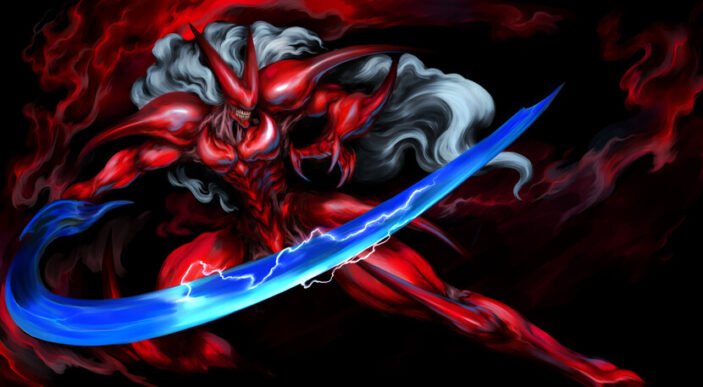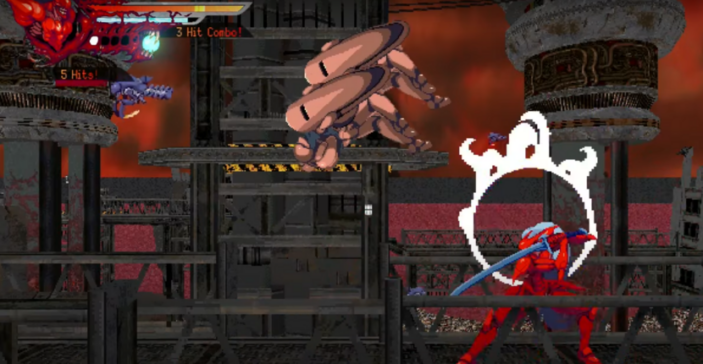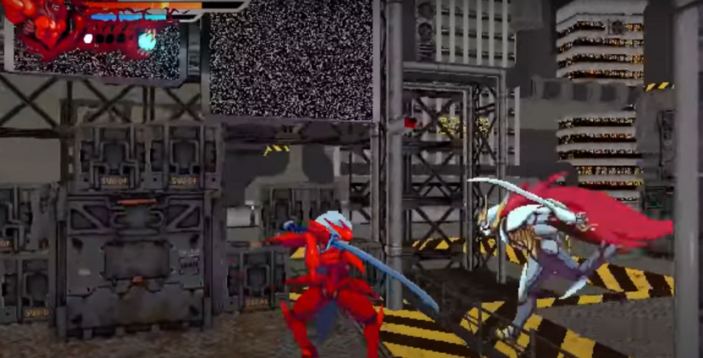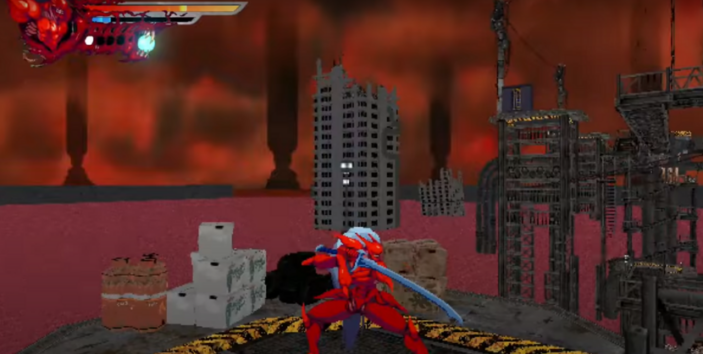
When it comes to reboots, remakes, and remasters, the Sega Dreamcast’s catalogue isn’t usually at the forefront of people’s minds. However, Slave Zero X surprisingly revives a long-dormant series with a prequel to the obscure 1999 release Slave Zero. Like many, I never played the original nor owned a Dreamcast, but fans of the classic will trade its third-person shooting for a claustrophobic, 2.5D hack-and-slash experience in this new iteration.
Set in a biomechanical nightmare soaked in H.R. Giger-inspired designs, Slave Zero X plunges players into a brutal “bio-punk” world straight out of an Alien movie. The story centres around Shou, who merges with a stolen Slave Unit Prototype mech suit, transforming into a near-unstoppable killing machine bent on revenge. Though there’s more depth than that, the narrative is secondary. The game knows this, too, hurling you into the action with minimal distraction from a plot that’s intentionally breezed through.
Brutal, Yet Rewarding
At its core, Slave Zero X is a traditional hack-and-slash affair with the arcade machine difficulty to boot. Don’t expect to button-mash your way through this one—the game quickly demands precision and strategy. You’ll need to master a variety of light and heavy combos, directional inputs, and jumps that raise the stakes with each encounter. The fast-paced combat leaves little room for hand-holding, and the sparse, text-only tutorial doesn’t do much to ease you in. But once you get into the rhythm, each battle is intense and satisfying.

The game truly shines when you’re facing one or two tough enemies, giving you the time to strategize and use your moves effectively. But when the screen floods with foes, you can quickly find yourself overwhelmed. The relentless waves of enemies, combined with the need for split-second decisions, can easily force you into survival mode, leading to some frustrating moments—especially when attacks come from off-screen.
Difficulty
Slave Zero X is all about balance, and its difficulty curve is steep. The game demands precise execution, and the lack of a robust tutorial makes this more challenging than necessary. From the outset, you’re hit with a wall of text explaining Shou’s abilities, which can be easily missed if you skip too quickly through the verbose explanations. Worse still, there’s no way to revisit this information outside of a training mode that resets your progress in the level. While the game offers upgrades for health and weapons to alleviate some of the difficulty, the learning curve is pretty unforgiving.
Controlling Shou also feels slow and unwieldy, particularly in the air, and the Nintendo Switch’s controls don’t help matters. The smaller gamepad feels less than ideal for the precision required in certain sequences, adding to the difficulty. This combination is a drawback for something that could really shine when you get accustomed to the way the game wants you to play, but ultimately the controls do take some of the shine off.
Level Design and Performance
The enemy designs in Slave Zero X are a high point, with distinct visuals that make it clear what type of foe you’re up against. However, the environments themselves are less impressive. The bio-punk aesthetic is consistent with the game’s overall atmosphere, but the level design itself offers little. While the bio-punk aesthetic is consistently striking, the level designs feel uninspired and visually dated. The game nails the retro feel it’s going for, but the catch-22 is that this look doesn’t stand up to today’s visual standards, even for throwback value. The result is a game that feels at home in the late ‘90s, but a little lacklustre by today’s standards.

The boss battles, however, are a major highlight. They’re varied, challenging, and will truly test your muscle memory. If you’re the type to get annoyed by easy boss fights, Slave Zero X has you covered—these encounters will demand the best of your abilities.
Unfortunately, on the Nintendo Switch, the game’s performance takes a hit. The combination of multiple enemies on screen, busy animated backgrounds, and the need for quick reactions leads to frequent frame drops, making combat feel sluggish and imprecise.
This is particularly frustrating for a game with 2D sprites and 3D environments in this era, which feels unacceptable. Platforming sections—already tricky due to Shou’s slow movement—become even more tedious when the game lags. These issues seem to stem from the platform itself, and it’s likely the game would run smoother on more powerful consoles.
Sound and Presentation
Where the visuals fall short, the sound design excels. The soundtrack, driven by pulsating drum-and-bass beats, keeps the adrenaline pumping throughout the combat. It adds an energetic edge to the game, elevating even the most repetitive encounters with a hypnotic rhythm. The sound effects are equally strong, with satisfying slashes and explosions that lend weight to each action.

One downside to this however is the game repeatedly attempts to deliver dialogue during gameplay, which is both distracting and fails to allow the story to be conveyed effectively. Key information is typically given while you’re fighting for your life in some of the game’s most difficult sections, meaning plenty of story is lost.
Replay Value
Clocking in at around five hours, Slave Zero X offers a brief but intense experience. The short campaign might encourage replays for those looking to perfect their skills, though the steep difficulty curve could deter less experienced players from revisiting it.
Final Thoughts
Slave Zero X will likely appeal to a specific audience—those who enjoy punishing combat, methodical hack-and-slash mechanics, and a throwback to old-school, arcade-style difficulty. While the game succeeds in creating a tight, rewarding combat system, its performance issues on the Switch, weak tutorial, and sluggish controls hold it back.
For those willing to invest the time and energy into mastering its systems, Slave Zero X offers a nostalgic, challenging experience. But for modern players expecting a more polished product, it might be a tougher sell.
![]()
![]()
![]()
![]()
![]()
THREE STARS (OUT OF FIVE)
Highlights: Challenging and rewarding combat system; Enemy variety and design stand out
Lowlights: Inconsistent platforming mechanics with sluggish movement; Visually dated graphics
Developer: Poppyworks
Publisher: Ziggurat
Platforms: PlayStation, Xbox, Steam
Available: Now
Lead artwork courtesy of Francine Bridge
Review conducted on Nintendo Switch with a pre-release code provided by the publisher.
